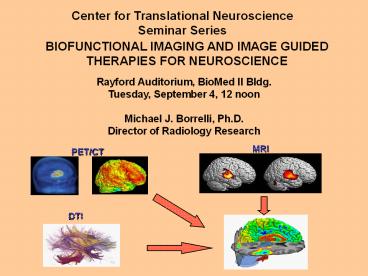DTI - PowerPoint PPT Presentation
1 / 2
Title: DTI
1
Center for Translational NeuroscienceSeminar
Series
BIOFUNCTIONAL IMAGING AND IMAGE GUIDED THERAPIES
FOR NEUROSCIENCE
Rayford Auditorium, BioMed II Bldg. Tuesday,
September 4, 12 noon Michael J. Borrelli,
Ph.D. Director of Radiology Research
MRI
PET/CT
DTI
2
Molecular imaging modalities like PET/CT and MRI
spectroscopy (MRS), and other biofunctional
imaging techniques like functional MRI (fMRI) and
diffusion tensor imaging (DTI), can be used
repeatedly to non-invasively obtain quantitative
information about neurological activity,
biochemistry, and physiology. Such biofunctional
imaging data can be fused with high resolution
morphological CT, MRI and Ultrasound images to
link structure with function for both normal and
diseased tissues. These imaging techniques and
many of their applications will be presented and
discussed. These modalities can be used to image
and quantify the delivery and efficacy of
therapeutic treatments and agents throughout a
treatment regime . Clinic-ally relevant
information can be obtained that can help
personalize treatments for each individual
patient, e.g. by indicating which patients are
responding well or poorly. The latter can be
treated more aggressively or moved on to another
treatment regime that might prove more
effective. Non-invasive imaging also permits
obtaining information during longer, longitudinal
studies with the same animals, which will improve
developmental studies, help reduce experimental
variability, and reduce the number of animals
needed for many studies. Invasive measurements
and periodic biopsies can be used to confirm the
results of the imaging procedures, which will
help define the usefulness and value of these
imaging modalities.































